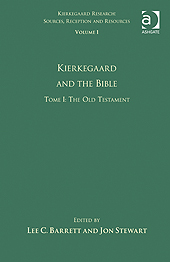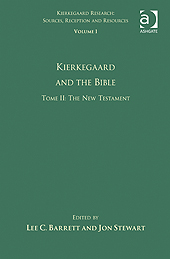
Kierkegaard Research: Sources,
Reception and Resources
|
||

  |
||

|
Edited by Lee C. Barrett and Jon Stewart
Tome I: The Old Testament
The articles in this volume all explore
Kierkegaard’s complex use of the Bible, a use that pervades and sometimes
even structures his literature. The authors of these essays use
source-critical research and the tools of many different disciplines,
ranging from literary criticism to theology and biblical studies, to situate
Kierkegaard’s appropriation of the biblical material in his cultural and
intellectual context.
Although Kierkegaard certainly cited the Old Testament much less frequently than he did the New, passages and themes from the Old Testament do occupy a position of startling importance in his writings. Old Testament characters such as Abraham and Job often play crucial and even decisive roles in his texts. Snatches of Old Testament wisdom figure prominently in his edifying literature. The vocabulary and cadences of the Psalms saturate his expression of the range of human passions from joy to despair. The essays in this first tome seek to elucidate the crucial rhetorical uses to which he put key passages from the Old Testament, the sources that influenced him to do this, and his reasons for doing so.
Table of Contents
Kierkegaard’s
Rewriting of Biblical Narratives: The Mirror of the Text
Kierkegaard’s Use of
the Apocrypha: Is It “Scripture” or
Reviews “Martin Luther said, ‘Oratio, meditatio, tentatio facit theologum,’ that is, the proper way to grasp Holy Scripture is through prayer upon the text, meditation upon the text, and agonizingly realizing the text in one’s own life. Kierkegaard’s approach to Holy Scripture especially mirrors the latter, as revealed in Kierkegaard and the Bible, Tome I, The Old Testament, edited by Lee C. Barrett and Jon Stewart….This excellent compendium from scholars around the world shows that while Kierkegaard was fully aware of the increasingly academic and critical approaches to the Bible, his own hermeneutic remained devotional and agonizingly subjective….In the midst of the rise of the historical-critical method in Kierkegaard’s academic setting, Kierkegaard responds not with Fundamentalist retort, but with the existential concern of the Pietists and Luther before an exacting God. This excellent tome on Kierkegaard’s approach to the Old Testament resounds with Luther’s hermeneutic rule: ‘tentatio facit theologum.’ ”David Lawrence Coe, Søren Kierkegaard Newsletter, no. 58, November 2011, pp. 6-7. ____________________
“This excellent collection of essays brings together the best contemporary Kierkegaard scholarship. Kierkegaard’s varied treatments of Scripture are analyzed across the expanse of his many pseudonymous literary works and his extensive journals (in which one often finds his most resolved theological views). Key biblical figures such as Adam, Abraham, Moses, David, Solomon and Job are read afresh through Kierkegaard’s eyes, penetrating beyond the old familiarity of characters and narratives to impact the reader as an individual, divorced from extraneous academic barriers. Though this first Tome focuses on the Old Testament, inevitably there is frequent reflection upon the New Testament, as befits Kierkegaard’s Lutheran hermeneutic. This volume combines superb primary research and exegetical content of Kierkegaard’s insights, interspersed with key biographical and historical details that had a significant impact upon his life and thought, such as his academic education in Copenhagen, his broken engagement, and his outspoken criticism of the Danish National Church. Kierkegaard’s re-telling of the Biblical narratives, in seeking to remove the barriers between reader and text, immerse the individual in the midst of the biblical material. This is a valuable resource not only for charting and reanalyzing Kierkegaard’s philosophy in light of Scripture, but for reanalyzing one’s own.” Aaron Edwards, Theological Book Review, vol. 22, no. 2, 2010, pp. 3-4.
As with the Old Testament, Kierkegaard was aware of new developments in New Testament scholarship and troubled by them. Because these scholarly projects generated alternative understandings of the significance of Jesus, they impinged directly on his own work. It was crucial for Kierkegaard that Jesus is presented as both the enactment of God’s reconciliation with humanity and as the prototype for humanity to emulate. Consequently, Kierkegaard had to struggle with the proper way to persuasively explicate the significance of Jesus in a situation of decreasing academic consensus about Jesus. He also had to contend with contested interpretations of James and Paul, two biblical authors vital for his work. As a result, Kierkegaard ruminated about the proper way to appropriate the New Testament and used material from it carefully and deliberately. The authors in the present New Testament tome seek to clarify different dimensions of Kierkegaard’s interpretive theory and practice as he sought to avoid the twin pitfalls of academic skepticism and passionless biblical traditionalism.
Table of Contents
Part I: Individual Texts and
Figures
Reviews “Lee C. Barrett and Jon Stewart have provided for the international community of Kierkegaard scholars a much needed work on Kierkegaard and the Bible, Vol. I of Kierkegaard Research: Sources, Reception and Research, which is under the editorship of Stewart….The contributors to this volume come from a wide geographical range of countries and various kinds of institutions….Each author in the volume has written with keenness of mind and heart about Kierkegaard and his approach to the Bible. The book makes a very significant contribution to Kierkegaard and biblical scholarship. May it receive the kind of attention in the scholarly community it so richly deserves.”Brian C. Barlow, Søren Kierkegaard Newsletter, no. 58, November 2011, pp. 8-9.
|
Kierkegaard and the Bible,
Kierkegaard and the
Kierkegaard and the
Patristic and Medieval Traditions
Kierkegaard and his
Kierkegaard and his
|
|
The
series Kierkegaard Research: Sources,
Reception and Resources is published Routledge Research, Philosophy
Routledge / Taylor & Francis Group, 711 Third Ave., Eighth Floor, New York, NY 10017, USA
|
||









